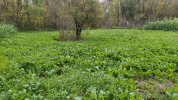Wind Gypsy
5 year old buck +
I intend to create plots out of what has been hay ground for decades but has not been cut for at least a couple years.
I'm hoping to do a prescribed burn on the majority of it as soon as possible (guessing late April or May) and follow up with gly on new growth. I want to get something planted just to compete with weeds prior to my fall plots going in. I was thinking buckwheat, oats, and a legume. The catch is I could see this planting happening in late May into June and I plan to do a Lick Creek'ish rotation for fall which means brassicas in mid july and grains probably in early August. That doesn't leave much time for the summer planting to get established.
Now to my questions -
1. Does it make sense to plant something even if it's getting terminated 45-60 days later? I thought it might be beneficial to outcompete weeds and add food/biomass to these new fields.
2. Does my plan of oats/buckwheat make sense and would adding a legume for that short period even help with nitrogen fixing? What legume would make sense?
The below thread has some pictures of what some of this ground looks like for reference. I've learned a lot since last August when that was posted!
I'm hoping to do a prescribed burn on the majority of it as soon as possible (guessing late April or May) and follow up with gly on new growth. I want to get something planted just to compete with weeds prior to my fall plots going in. I was thinking buckwheat, oats, and a legume. The catch is I could see this planting happening in late May into June and I plan to do a Lick Creek'ish rotation for fall which means brassicas in mid july and grains probably in early August. That doesn't leave much time for the summer planting to get established.
Now to my questions -
1. Does it make sense to plant something even if it's getting terminated 45-60 days later? I thought it might be beneficial to outcompete weeds and add food/biomass to these new fields.
2. Does my plan of oats/buckwheat make sense and would adding a legume for that short period even help with nitrogen fixing? What legume would make sense?
The below thread has some pictures of what some of this ground looks like for reference. I've learned a lot since last August when that was posted!
Newby Central MN Hayfield to food plots
Hi folks, new member here and am about to close on 40 acres in kanabec county MN. There is a lot of good cover but about 8 acres of the land is historically hay field. The previous owner stopped haying it 3 or 4 years ago and has been letting most of it just do it's thing. A couple acres he has...
habitat-talk.com

